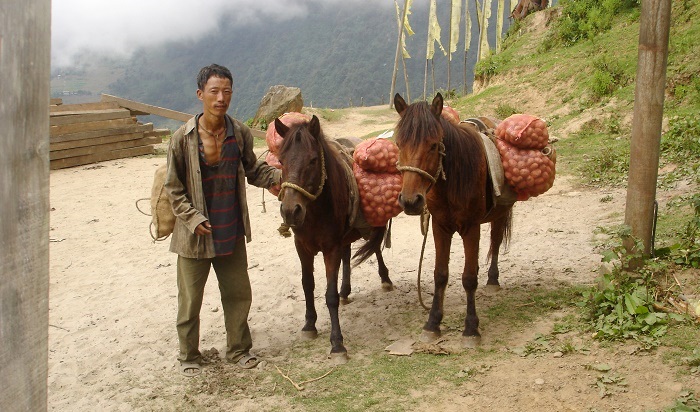Strengthening linkages between value chain actors, service providers and enablers is important in achieving sustainable growth in Hindu Kush Himalayan region
By Dr Surendra Raj Joshi
The bountiful mountain areas of the Hindu Kush Himalayan (HKH) are a cornucopia of diverse, high-value products. With an abundance of niche goods, the region has a comparative advantage over other markets due to the increasing demand for high-quality, unique, natural products derived from traditional know-how. Specialty crops and value-added products offer opportunities for mountain communities to earn higher prices and increase profits. Fruits, nuts, root crops, vegetables, legumes, spices, condiments, tea, coffee, cut flowers and ornamental foliage are all considered high-value specialty crops that significantly contribute to the mountain economy. In addition, mountain communities offer non-timber forest products, cold water fish, honey, livestock products, handicrafts, handmade papers, pashmina and woolen products easily distinguishable and capable of fetching a better market price.
In Gilgit-Baltistan, production of apricot, cherries, figs, plums, peaches, pine nuts, walnuts, sea buckthorn, wild thyme, black cumin, chamomile, stevia, and silajeet is contributing to the livelihoods of more than 50 percent of rural households. In Nepal, high-value products such as ginger, turmeric, timur (Nepali pepper), coffee, orthodox, tea, cardamom, honey, medicinal and aromatic plants including yarchagumba (cordyceps) also provide a livelihood base to many rural households. For example, in the coffee value chain, more than 30,000 households produced 524 tonnes of coffee in fiscal year 2013/14, of which, Nepal exported about 65 percent. Similarly, Nepal produces about 4,500 tonnes of high-quality orthodox tea annually, an in- demand product in high-value markets. Likewise, large cardamom generates substantial income to rural farmers. According to the Trade and Export Promotion Centre, Nepal exported more than 4,900 tonnes of large cardamom valued at Rs 4.27 billion in the fiscal year 2013/14.
Bhutan’s high-value products include apple, oranges, spices, medicinal and aromatic plants, incense sticks, handwoven clothes, and dairy products. Mandarin oranges are first in export earnings in relation to other horticultural commodities, with a gross product value of over $22 million. According to the Ministry of Agriculture and Forest, more than 25,500 metric tons of mandarin were exported to Bangladesh and nearly 9,000 tonnes to India in 2014/15. The country also exported more than 5,000 tonnes of apples worth $3.5 million to India and nearly 1,400 tonnes worth more than $900,000 to Bangladesh in 2014.
In the hill districts of Bangladesh, there are a range of products grown in ‘jhum’, the traditional shifting cultivation practice, which are ‘organic by default’. Weaving, bamboo crafts, and a unique style of food preparation using ingredients collected from the forest, are some of the key attraction for locational marketing.
In mountain regions of China, products such as walnut, tea and garlic not only support local food security and livelihoods of most farmers through generating high income, but also significantly contribute to the national economy. Similarly in Afghanistan and Myanmar, fruits, nuts, handicrafts, and precious stones provide a livelihood base to mountain communities.

Challenges to harness high-value market
Mountain people typically face many difficulties producing, marketing and selling high-quality, high-value products. Weak communication infrastructures; lack of information, training and expertise in new agricultural and other technologies; lack of registration; certification and labelling to protect products; inadequate marketing skills; lack of wider market access; high transport costs; and unfair trade all pose obstacles.
Mountain people rarely explore the market potential of high-value products. Often, they are still engaged in producing staple commodities whose prices are declining. Consumers don’t always distinguish mountain products (particularly those products which are also grown in plains, e.g. honey) from others when displayed in the marketplace. Cost of production of many such products are lower in plains, thus mountain farmers face increasing competition with products grown by large holders in plains due to lack of proper traceability mechanism for geographic origin. Beekeepers in the plains can get 50-60 kg/colony/year from the European honeybee; whereas beekeepers in mountain areas hardly get 10-12 kg/colony/year from the native bee. Both honeys look alike, but mountain honey has some unique ingredients that make it more hygienic and healthy. A lack of collective marketing is also a challenge. The HKH region is the largest producer of ginger in the world; China ranks as the world’s largest producer followed by India and Nepal, but common standards and collective labelling are lacking.
Though the potential to increase incomes and improve the livelihoods of mountain farmers exists, there are challenges to overcome. How can we transform mountain farmers’ products into high-quality and high-value ones? And how can we enable mountain people to compete in markets and fetch premium prices for their goods and services at home and abroad?

Potential to tap into a high-value market
The HKH region offers huge potential to tap into a high-value market. Collective labelling (i.e. one region, one product, one standard) and branding are important areas for collaboration to tap into high-value markets. Many consumers seek more wholesome products which reflect their values and are willing to pay more.
Linking small farmers with customers is key to improving livelihoods. Consumers trust small farms more than large industrial farms to produce safe food responsibly. ‘Farmer-owned cooperatives’ and other ‘joint marketing setups’ need to be developed to get small farms connected to the customers in high-value markets.
Adding value to agricultural products yields higher investment returns, creates opportunities to open new markets, extends the producer’s marketing season, and establishes new recognition for farms. Strengthening linkages between value chain actors, service providers and enablers is important in achieving sustainable growth. Strengthening farmers’ groups and cooperatives ensures bulk supply and improve bargaining power. Strengthening business relationships of producer groups and cooperatives moves into joint processing and marketing adding value. Encouraging producers to take up some pre-processing functions such as cleaning, sorting, grading, etc. instead of supplying unprocessed products, streamlines production. Improving access to information and services benefits all allowing groups and cooperatives to tap into high-value markets.
—
The author, Dr Surendra Raj Joshi, is High-Value Products Specialist, Livelihood Thematic Area at the International Centre for Integrated Mountain Development (ICIMOD).
He can be reached at Surendra.joshi@icimod.org





